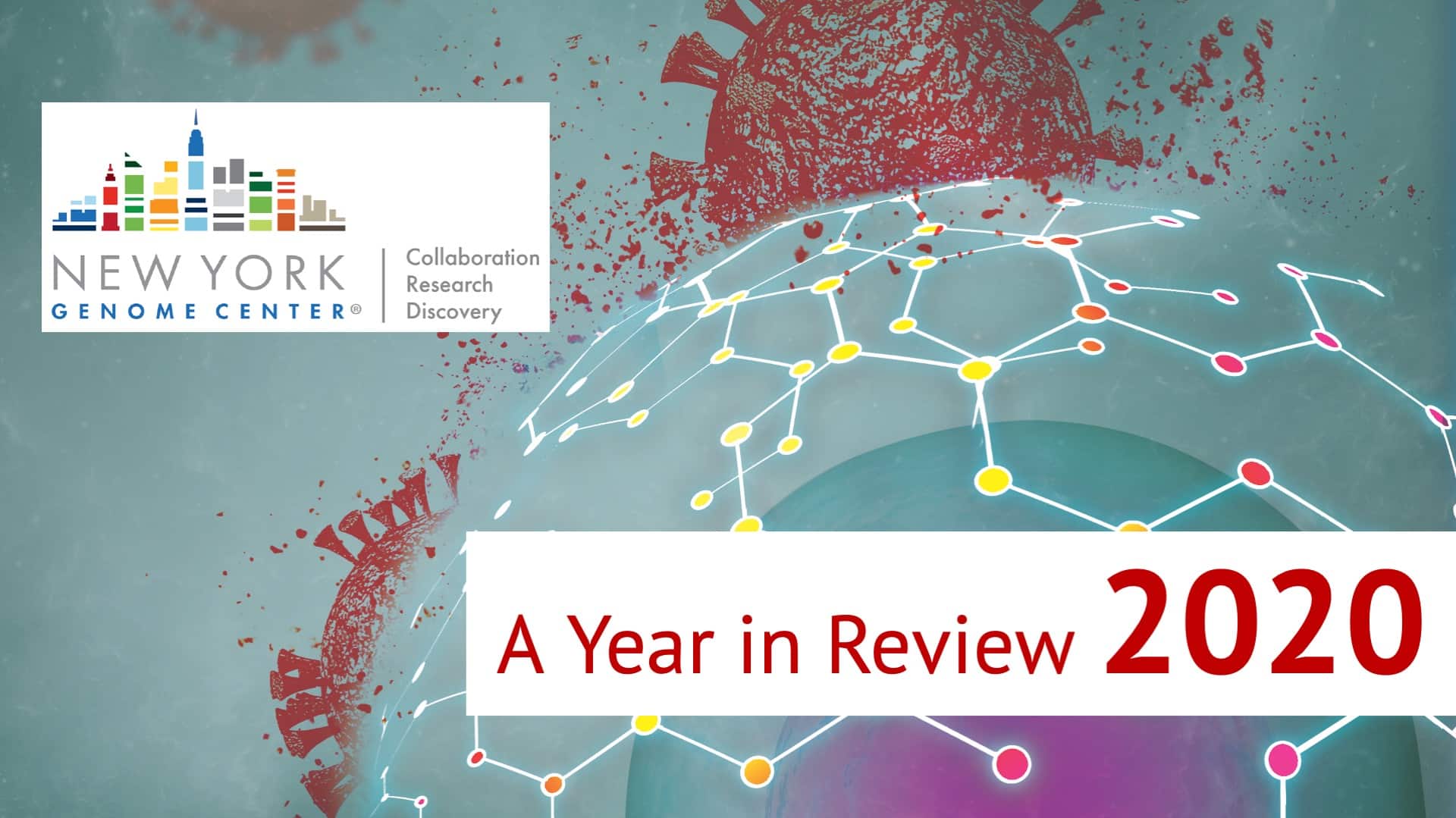Accelerating COVID-19 Genomics Research, Sequencing, and Testing
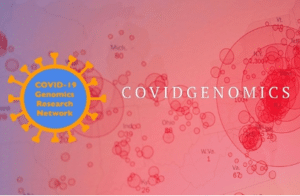
In March, the NYGC launched the COVID-19 Genomics Research Network (CGRN), a new multidisciplinary consortium with the goal of developing collaborative research projects with the NY scientific community to understand how the SARS-CoV-2 virus spreads, how the immune system responds, why some people are minimally affected while others are severely impacted, and which pharmaceutical strategies might optimally help reduce the spread and alleviate symptoms.
A chief goal of the CGRN is to combine clinical and genomic data generated from patients in an NYGC-hosted data commons for participating physicians and scientists. This resource will help support ongoing efforts to improve treatment of patients and further studies to understand the disease, evolution of the virus, and long-term impact on population health. CGRN meetings, held biweekly since the network’s formation, have become a critical information-sharing forum for the worldwide COVID-19 genomics community, with up to 250 researchers and clinicians from around the globe regularly attending these virtual meetings.
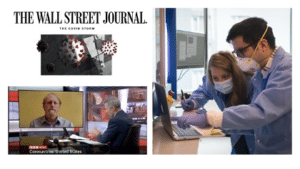
As part of the CGRN, NYGC is sequencing samples for COVID-19 research, including for the partnership, announced by Governor Cuomo in May, between the NY State Department of Health, the NYGC, and The Rockefeller University to better understand COVID-19 related illness in children. The NYGC is also one of 50 sequencing hubs involved in the international COVID Human Genetic Effort, led by Jean-Laurent Casanova, MD, PhD, at The Rockefeller University and Helen Su, MD, PhD, at the National Institute of Allergy and Infectious Diseases,, which reported its first findings, in Science, in September. These studies revealed that some people develop severe COVID-19 due to faulty genes or misguided antibodies, resulting in a deficit of type I interferons, a set of proteins vital in protecting against viruses. The studies were selected by Nature as among the top 10 discoveries of 2020, across all scientific fields. The NYGC’s COVID-19 genomics research was featured in The Wall Street Journal‘s September report, “The COVID Storm.” NYGC Scientific Director of Computational Biology, Michael Zody, PhD, was quoted in this story, as well as featured on BBC television to explain the genomic structure of the virus. These and other NYGC COVID-19 genomics news stories can be found in the COVID-19 Genomics section of the NYGC website.
Using CRISPR to Find New Therapies for COVID-19
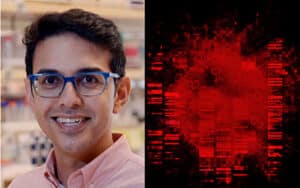
“We felt that we could use the high-throughput CRISPR gene-editing tools that we have applied to other diseases to identify which key human genes are required by the SARS-CoV-2 virus. Our goal was to better understand how the virus depends on its host and whether we could find drugs to target those critical dependencies,” is how NYGC Core Faculty Member Neville Sanjana, PhD, has described the genesis of the groundbreaking study co-led by his lab, which was published in Cell in October. The study was a close collaboration with the lab of Ben tenOever, PhD, at Mt. Sinai. The study team performed a genome-scale, loss-of-function CRISPR screen to systematically knock out all genes in the human genome, identifying the genes — and thus potential drug targets — that protect against SARS-CoV-2 infection. The researchers used a broad range of analytical and experimental methods to validate their results, including repurposing existing FDA-approved drugs to combat the virus. Contributors to this integrative study include scientists from the Technology Innovation Lab, the Center for Genomics of Neurodegenerative Disease, and the Lappalainen Lab. In the Sanjana Lab, the work was led by postdoctoral fellow Zharko Daniloski, PhD. The artwork featured above and on this newsletter’s header was developed by the Sanjana Lab team to provide dramatic depictions of how the coronavirus, with its crown of spike proteins, moves within the inter- and intra-cellular “deep space” of the human genome. Read more about the study and related media coverage, including a CNBC report on its findings, here.
Collaborating on New Clinical Whole-Genome Sequencing Initiative to Expand Patient Access to Advanced Genomic Technologies
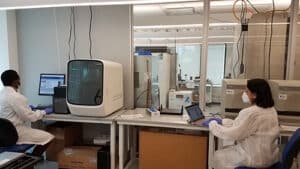
Since April, NYGC’s Clinical Laboratory has been conducting COVID-19 clinical testing for various healthcare and government entities, in collaboration with renegade.bio. The lab was granted permission from the FDA to conduct its testing using an innovative approach to expedite testing turnaround time and in November, the lab also received emergency use authorization to deploy a rapid-response saliva test as part of its testing toolkit.
Early this year, the Clinical Lab received approval from the NY State Department of Health (NYS DOH) to run its clinical constitutional whole genome sequencing (WGS) testing on the Illumina NovaSeq platform. In December, it was announced that the NYGC will sequence the whole genomes of thousands of patients receiving care at Weill Cornell Medicine (WCM) and NewYork-Presbyterian Hospital (NYP), making this one of the largest clinical whole genome sequencing programs in the country. The NYGC Clinical Lab’s board-certified molecular geneticists will interpret and return the results to physicians, who may then share them with their patients. The initiative, which also includes a partnership between WCM, NYP, and Illumina, has been established to study the feasibility and viability of a large-scale implementation of whole-genome sequencing within a major metropolitan health care system in the United States. The NYGC was the first sequencing center in the country to obtain regulatory approval for clinical whole-genome sequencing tests for genetic diseases and cancer from the NYS DOH, which has been active since 2018. “Whole-genome sequencing and advanced bioinformatics will provide clinicians with a patient’s complete genetic ‘code,’ which can be interrogated throughout their lives as our understanding of the relationship between individual genetic variation and disease advances, and new life-saving therapies are developed,” noted NYGC Evnin Family Scientific Director and CEO Tom Maniatis, PhD, in the announcement about the initiative. For more about this announcement and related media coverage, click here.
Leading a New CEGS-Designated Center for Integrated Cellular Analysis
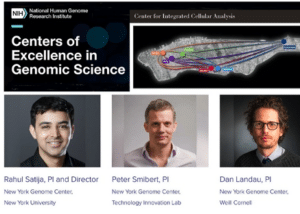
“All three of us were thinking about this problem in our own lanes and decided to join forces,” is how NYGC Core Faculty Member Rahul Satija, PhD, explained, in a Q&A with CZI Science, the motivation to form the Center for Integrated Cellular Analysis with NYGC Technology Lab Director Peter Smibert, PhD, and NYGC Core Faculty Member Dan Landau, MD, PhD, as co-principal investigators (PIs). Funded through the Centers of Excellence in Genomic Science (CEGS) program of the National Institutes of Health’s National Human Genome Research Institute, the Center includes investigators from six institutions in New York City, including NYU and WCM where Drs. Satija and Landau, respectively, hold joint appointments. Center collaborators seek to develop a comprehensive suite of technologies and analytical methods to measure and integrate the molecular and environmental determinants of cellular identity. “We want to be able to measure as much as we possibly can, all in the same cells and all at the same time. And, of course, that’s going to require technology development, as well as the development of some very exciting computational algorithms to make sense of all that data,” Dr. Satija said. The Center, launched over the summer, participated in its first CEGS annual research symposium in October. Stay up to date on this important initiative through its website multimodalintegration.org.
The three NYGC PIs for the Center also continued to develop and deploy pioneering multimodal single-cell technologies this year:
Promoting Better Care and Outcomes Through New Multi-Institutional Cancer Genomics Projects Focused on Underserved Populations
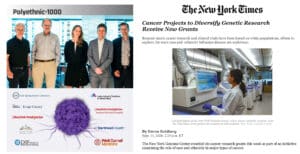
“Leaving people out is an equity issue and a knowledge issue,” noted Harold Varmus, MD, in the September 11 feature story in The New York Times about the NYGC’s Polyethnic-1000 (P-1000) initiative, which was awarded additional grant funding in 2020 to support the program, including seven new multi-institutional cancer projects focused on underserved populations. The award-winning new projects will investigate a variety of cancers including pancreatic, colorectal and endometrial cancer in African Americans; lung cancer in Asian American patients; breast and prostate cancer in patients of African ancestry; multiple myeloma in African Americans; and the role of ethnicity in bladder cancer. The P-1000 initiative is overseen by the NYGC’s Genome Center Cancer Group, led by Dr. Varmus, Senior Associate Core Member, NYGC, and Lewis Thomas University Professor of Medicine, WCM, and Charles Sawyers, MD, Chair, Human Oncology and Pathogenesis Program, Marie-Josée and Henry R. Kravis Chair, Memorial Sloan Kettering Cancer Center, and Affiliate Member, NYGC. The group is composed of clinicians and cancer researchers from NYGC’s member institutions, including 10 National Cancer Institute-Designated Cancer Centers. Read The New York Times story and more about the new projects here.
Advancing Lab-Developed Liquid Biopsy Technology To Validation Trials
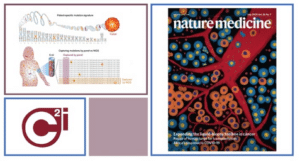
NYGC Core Faculty Member Dan Landau, MD, PhD, and his research team have developed a whole-genome sequencing technology powered by machine learning that is able to identify very low levels of tumor DNA in blood samples to enable the early detection of cancer recurrence after surgery or treatment. The proof-of-concept data of this landmark liquid biopsy method was published in Nature Medicine in June, with NYGC Computational Biology team members among the co-authors. Also in June, C2i Genomics, the NYGC spinout company founded in 2019 by Dr. Landau and Asaf Zviran, PhD, to develop and commercialize this technology, announced it had raised $12 million in Series A financing and begun to initiate several retrospective and prospective validation trials with clinical centers in the U.S. and Europe. “This is the ambition: to be able to switch between therapies to provide adequate therapy based on real time monitoring of disease,” Dr. Landau noted in a BioWorld article. Access this article and learn more about the study and C2i Genomics here.
Uncovering Genetic Functionality and Variation That Will Empower Genomics Research and Drug Discovery
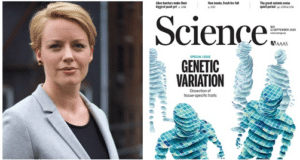
September 10, 2020 was a banner day for human genomics: The multi-institutional Genotype-Tissue Expression (GTEx) Consortium, in a final-phase collaborative initiative co-led by NYGC Core Faculty Member Tuuli Lappalainen, PhD, released its final set of 15 papers in Science and other journals. The culmination of a 10-year effort funded by the National Institutes of Health, the GTEx research presents a comprehensive atlas that maps how genetic variants affect gene regulation and how these cellular changes contribute to genetic risk for both common and rare diseases and traits. “GTEx resources also empower other studies by the genomics community, including disease-specific research, the identification of targets for drug development, and understanding genome function,” noted Dr. Lappalainen in the news release, which provides further details on the research findings and contributions by the Lappalainen Lab team.
Revealing Patterns In How Tumors Extensively Rewrite Their DNA
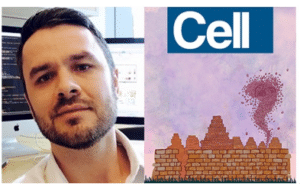
“Algorithm Uncovers New Complex Rearrangement Classes in Cancer Genomes,” was how GenomeWeb headlined its report on the study led by NYGC Core Faculty Member Marcin Imielinski, MD, PhD, published in Cell in October, that identified three new distinct classes of structural variations in the DNA of thousands of cancer samples across multiple cancer types. These discoveries help explain different mechanisms that enable cancer cells to expand and grow rapidly while simultaneously evading natural defense mechanisms and treatment. The research team is continuing to apply its structural variant detection strategy to cancer cases and expects the approach to become more widespread in clinics and in research labs in the future. “In a few years, it’ll be both feasible and practical to be doing this routinely,” Dr. Imielinski, who holds a joint appointment at WCM, said in the press release that accompanied the publication. NYGC contributors to the study include NYGC Core Faculty Member David Knowles, PhD, and the NYGC’s Clinical Lab and Computational Biology teams. For the press release and GenomeWeb article, click here.
Exploring the Cellular Events That Lead to Neurodegenerative Disease And Fostering Integrative, Collaborative ALS Research
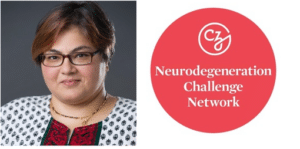
Could overcrowded protein in cells kickstart neurodegeneration? That is the biological question that Hemali Phatnani, PhD, Director, Center for Genomics of Neurodegenerative Disease (CGND), NYGC, is exploring in a collaboration with NYU’s Liam Holt, PhD, in a project awarded a pilot grant through the Chan Zuckerberg Initiative’s Neurodegeneration Challenge Network program in August. The team is utilizing a mix of emerging technologies, including cutting-edge microscopy methods, genetically encoded nanoparticles, and spatial transcriptomics, to track what is happening inside neurons during phases of protein aggregation, a common pathological hallmark of neurodegenerative diseases including ALS, Alzheimer’s, and frontotemporal dementia. While protein aggregation has been a topic of intense study in the neurodegeneration field, the team’s approach is unique, enabling monitoring of these cellular events in live cells in real time. Learn more about the project here.
The NYGC’s ALS Consortium, a global collaboration of clinicians, scientists, geneticists, and computational biologists organized by the CGND, added six new members this year, for a total of 38 members worldwide. The members that joined in 2020 are: Broad Institute, Korea Advanced Institute of Science and Technology, Northwell Health, Tel Aviv Sourasky Medical Center, The Translational Genomics Research Institute (TGen), and the University of California San Diego. Through the data-sharing repository maintained by the CGND, the ALS Consortium is developing an ever-growing resource of genomic sequencing and clinical data. By year-end 2020, 3,637 whole genomes and 1,938 RNA samples from ALS patients will have been sequenced and analyzed, making this dataset, available to all researchers, one of the largest ALS cohorts in the world.
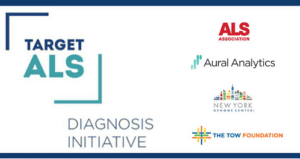
In December, the medical research foundation Target ALS, which provides support to the CGND and contributes ALS patient samples to its repository, launched The Target ALS Diagnosis Initiative, the first-ever comprehensive effort to discover ALS biomarkers. This new program includes developing an integrated biofluid and genomics core made possible through existing alliances between Target ALS, The ALS Association, The Tow Foundation, and the NYGC, as well as a new partnership with Aural Analytics. Together, the partnership will interrogate the pathogenesis of ALS using patient biofluids — including the analysis of longitudinally sampled cerebrospinal fluid, blood, and urine — as the disease progresses. “The more types of data you can study together, the more powerful your approach becomes to better understanding the mechanisms and progression of ALS,” said Dr. Phatnani in an interview posted on the Target ALS blog shortly before the announcement. Read the announcement about the initiative here.
Developing A New Statistical Tool to Improve Analysis of BioBanks and Using Machine Learning to Uncover the Novel Therapeutic Targets for Alzheimer’s Disease
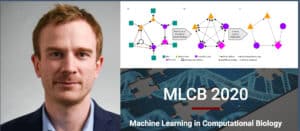
“Super clever approach for a very challenging problem,” was how one commentator reacted to the release of “bimmer,” a novel statistical tool detailed in the inaugural pre-print, posted in June, from the lab of NYGC Core Faculty Member David Knowles, PhD, who joined the NYGC, with a joint appointment at Columbia University, in 2019. The new method improves the ability to infer sparse networks of direct causal effects from phenome-scale GWAS summary statistics. In August, Dr. Knowles and collaborator Towfique Raj, PhD, a core faculty member at Mt. Sinai’s Ronald M. Loeb Center for Alzheimer’s Disease, were awarded a U01 grant from the National Institutes of Health for their project “Learning the Regulatory Code of Alzheimer’s Disease.” The team will use machine learning algorithms and build computational models to uncover which genes, pathways, and molecular mechanisms are involved in Alzheimer’s that will provide novel therapeutic targets for patients.
Expanding NYGC’s Neuropsychiatric Disease Collaborations
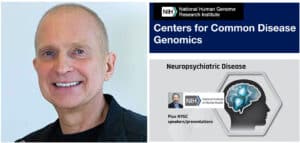
In January, Thomas Lehner, PhD, MPH, joined the NYGC as Scientific Director of Neuropsychiatric Disease Genomics to lead the expansion of the NYGC’s neuropsychiatric disease research program, focused on the genetic architecture of autism, schizophrenia, and bipolar disorder. Dr. Lehner is pursuing new collaborative opportunities both nationally and globally. He is hosting a series of seminars with potential collaborators representing the breadth of neuropsychiatric disease genomics. For example, in January, Dr. Lehner moderated a seminar by internationally renowned geneticist Mary-Claire King, PhD, who joined us as a consulting NYGC Senior Associate Core Member in late 2019, on schizophrenia genetics research that was published in Science later that month. Dr. Lehner is co-author of a commentary that appeared in The Lancet Psychiatry in May that advocates for further engagement between global mental health researchers and neurogeneticists in the context of African mental health. In June, Dr. Lehner, who came to the NYGC from a distinguished 15-year career at the National Institute of Mental Health (NIMH), hosted a virtual visit by NIMH Director Joshua A. Gordon, MD, PhD, to engage with NYGC faculty and staff scientists and discuss opportunities for collaboration. Dr. Lehner also leads our Neuropsychiatric Disease Scientific Working Group (NPDWG). “It is invigorating to work with such a diverse group of talented researchers dedicated to a common goal, which is understanding and ultimately finding treatments and cures for these diseases,” noted Dr. Lehner about working with this group. One of the signature projects of the NPDWG is the development of a New York-wide Precision Psychiatry cohort that will integrate diagnostic, demographic, and patient care data with genomic data and other medical records to provide a platform for scientific discovery, clinical validation, and translational implementation.
By year-end 2020, the NYGC also reached a significant milestone in its neuropsychiatric and neurodevelopmental disease research: NYGC teams have now sequenced and analyzed over 41,000 genomes, primarily of autism patients and their families, as a part of the Centers for Common Disease Genomics program with funding from the National Human Genome Research Institute and generous co-funding from the Simons Foundation.
Convening an International Scientific Advisory Board
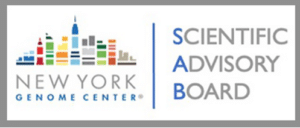
In 2020, the NYGC held two meetings with its new Scientific Advisory Board (SAB), which provides strategic advice and counsel in support of our scientific mission. Composed of leading international genomic scientists, and chaired by Barbara Wold, PhD, Bren Professor of Molecular Biology and Director of the Merkin Institute for Translational Research at the California Institute of Technology, the 10-member SAB offers guidance and input on research strategy from diverse perspectives to the NYGC. The wide-ranging expertise of the advisory board includes quantitative human genetics, neurogenetics, functional genomics, genomic technology development, computational biology, machine learning, population genomics, and cancer genomics. Read the NYGC’s December announcement about the SAB here.
Supporting Diversity, Equity, and Inclusion in the STEM Community
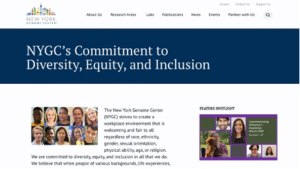
“The creation of forums to discuss the importance of equitable practices is vital,” notes Catherine Braine, a graduate student in the NYGC’s CGND, in a Q&A that is now part of a kaleidoscope of perspectives being featured on our new Diversity, Equity, and Inclusion section of the NYGC website. This section of our site and related social media messaging are part of a new initiative undertaken this year to affirm NYGC’s commitment to diversity, equity, and inclusion in the STEM community. Our newly formed Diversity, Equity & Inclusion Advisory Group (DE&I AG), consisting of team members across various departments, is supporting this commitment with a host of new internal programs, including a mentorship career panel and a diversity book club, which engendered lively discussions on relevant books like So You Want To Talk About Race and The Immortal Life of Henrietta Lacks. The NYGC is committed to addressing systemic racism in science and the workplace and affirms this commitment with the creation of the DE&I AG. “We continue to challenge ourselves as an organization, as well as the systems and practices that we have in place, with the goal of creating a more inclusive and equitable workplace and community,” said Banke Fagbemi, PhD, NYGC’s Director of Business Development and co-lead of NYGC’s DE&I AG.
2020 Recognition Award Winners
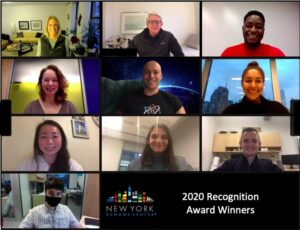
At NYGC’s 2020 Holiday Party, held virtually via Zoom on December 9, Tom Maniatis and Cheryl Moore announced the winners of our annual recognition awards. The winners each received a framed certificate and $2,500 cash award.
Below, more about this year’s winners:
The recipients of the Citizenship & Collaboration Award for exemplifying the mission and values of the NYGC by modeling teamwork and bringing out the best in others are:

Jaime McClintock, SeqOps Manager, Library Prep: Jaime has excelled as a strong leader of her team, helping to navigate the obstacles presented by the pandemic. Jaime led her team to deliver a record number of new assays and RNA library preps this year. She also prioritizes team-building exercises and is always willing to volunteer her time for non-lab related events.

Dino Robinson, Clinical Laboratory Supervisor: Dino constantly strives to help others, bringing an infectious, positive energy to NYGC and bringing people together. Dino represented the Clinical Lab at the February 2020 PCR Mixer, presenting his master’s thesis, Discrimination of Monozygotic Twins using DNA methylation levels of one CpG site at Chromosome 3. He also successfully co-leads NYGC’s Diversity, Equity & Inclusion Advisory Group that was established this year.
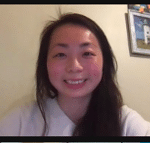
Ashley Yang, Software Engineer II: Ashley has become the go-to person in the NYGC Software Engineering team on all things Production and Clinical LIMS (Laboratory and Information Management Systems). She is an excellent communicator and goes above and beyond to bring her team together by organizing extra events like baby showers and team lunches. Her positive impact can be felt across NYGC.
The recipients of the Innovation & Discovery Award for the development of new ideas, projects or cost savings, and the continuous pursuit of positive improvements for the Center are:

Dominik “Dom” Biezonski, PhD, Senior Scientific Grant Writer: Dom has been an integral part of our research and grants team since he joined the NYGC in April 2019. He spent valuable time during his first few months meeting with each of the investigators with whom he’d be working, developing processes and strategies to best support each of them. He has since played a huge role in the shaping of grants that have been successful for the Center. Dom has also hosted internal, informational grant workshops – and you may recognize him from having held the first live-streamed musical performance in NYGC history.

Catherine Heywood, Application Scientist, Production Lab: Catherine was nominated for her work as part of the Diversity, Equity & Inclusion Advisory Group. She independently took the initiative to create the DEI Wiki Page, a collection of resources, both internal and external. The page, created in late June, continues to grow and was viewed almost 700 times in its first four months. On top of this, Catherine co-leads the group and has played a major role in all of the work that has been done in 2020.
The recipients of the Outstanding Contribution Award for a Postdoc & Student are:
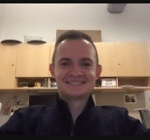
Zharko Daniloski, PhD, Postdoctoral Researcher, Sanjana Lab: Zharko has led two studies aiming to understand the biology of SARS-CoV-2. For the first, he performed a genome-wide CRISPR screen to identify human genes and pathways required for SARS-CoV-2 infection, in collaboration with Mount Sinai, that was recently published in Cell and provides a comprehensive map of the genes and pathways utilized by the virus, including potential therapeutic targets. In addition, Zharko led a second project that aimed to understand the function of a mutation frequently found in SARS-CoV-2. Again in collaboration with Mount Sinai, he has shown that D614G mutation found in the coronavirus Spike protein, increases the infection of SARS-CoV-2. Both studies were very well received within the scientific community and were highlighted in several media outlets, including The Washington Post, among others.
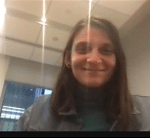
Efthymia “Effy” Papalexi, PhD Student, Satija Lab: Efi’s graduate project has been focused on the development of new methods to analyze and interpret multimodal single-cell screens, and to apply these to identify new molecular regulators of immune checkpoint proteins. Efi developed a novel computational framework, mixscape, to identify and remove confounding sources of variation in single-cell pooled screen datasets. In particular, she observed that a substantial fraction of cells receive a targeting gRNA but do not exhibit any phenotypic effects of perturbation; for example, due to the introduction of an in-frame mutation. Importantly, she developed a method to identify and remove these cells, which dramatically improves the ability to interpret these datasets and discover new biology. Efi’s tools represent a powerful and broadly applicable approach to performing perturbation screen. By releasing them as open-source software with extensive documentation, her work is already enabling multiple groups both within NYGC and the broader scientific community.

Timothy “Tim” Stuart, PhD, Postdoctoral Researcher, Satija Lab: Tim has led the development and publication of a new algorithm (and accompanying open-source software) to integrate diverse single-cell datasets together. He developed a powerful approach to ‘anchor’ datasets produced from different technologies together in order to ‘align’ shared cell types, solving a fundamental challenge that is faced by researchers far and wide. In this work, Tim has combined scRNA-seq, CITE-seq, ATAC-seq, and STARmap data to make a series of discoveries. However, the true value of his work lies in the discoveries that others have made as a result. By making his methods available as part of the open-source software on GitHub, Tim’s methods have had tremendous impact in the community. His manuscript has received more than 1,350 citations in the past year alone, as both individual labs and diverse consortia have applied his methods to analyze their single-cell data.
September – December 2020 Service Anniversaries
8 years
September: Frank Wos
November: James Spencer
7 years
September: Heather Geiger, Catherine Heywood
October: Farheen Shah
December: Anand Kumaraguru
6 years
September: Samantha Fennessey, Cindy Li, James Roche
October: Berrin Baysa, Kevin Shi
November: Stephane Castel
December: Eddie Luo, Dina Manaa, Rahul Satija
5 years
September: Dino Robinson, Jennifer Shelton
October: Steve Bavier, Adrienne Helland, Luke Kozon
November: Dan Landau, Nadia Propp
4 years
September: Luis Huang, Justin Maldonado, Joe Toledo
3 years
September: Stephanie Hao
October: Marta Byrska-Bishop, Sri Katragadda, Eleni Mimitou, Ashley Yang
2 years
September: Ken Lui, Sam Phillips, Lindsay Reisman, Josh Schiffman, Chao Yan
October: Alexi Runnels, Luisa Suarez
November: Jonathan Gaige, Dafni Glinos, Kevin Williams
December: Marcello Ziosi
1 year
September: Will Hooper
November: Kathryn Bedrosian, Isabelle Schmutz
December: Athena Tsu
